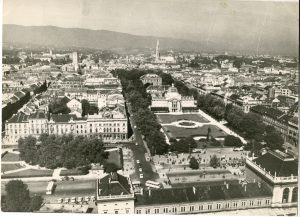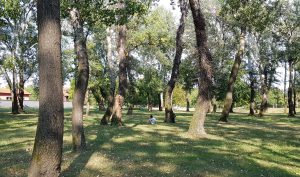
November 21, 2018, by lzzeb
Researching the history of greenspace in Croatia to inform the planning for sustainability
A blog by PhD student Neven Tandarić on his research
The interface between the environment and society is essential to geographical research. It links the two large domains through the space-time continuum. Reflections of the interaction between the two domains are materialised in space providing us with the subject of study. The dynamic of scientific progress creates the research topics virtually on a daily basis. We aim at exploring unknown to understand how the world functions. But increasingly we are trying to find answers to problems the contemporary society is facing. For the last few centuries, the science came up with fantastic technological solutions that perpetuated the scientific progress but more importantly it enabled the exponential population and economic growth and improvement in living standards all over the world. Yet, the growth exceeded the carrying capacity of the biosphere due to which human society is faced with environmental problems at different scales. Attempts in finding solutions to these problems are the driver of most studies on the interface between environment and society.
My research is also one of such endeavours. After obtaining MSc in physical geography, I started working in urban planning in Zagreb, Croatia. Being involved in local development plans making, I was trying to plan for the nature-based solutions that would lead to long-term sustainable development. Unfortunately, fairly soon I realised that the lack of both the funds and ecological awareness would halt the implementation of such solutions. It struck me that we have plenty of environmental solutions available around us, but we do not have means (n)or knowledge to utilise them. That is how my PhD journey began. Together with my supervisors, I developed a project addressing the utilisation and planning of nature’s contributions to the urban population. To do that I will study how the perception, appreciation, use and planning of urban nature in Croatia operated and changed over the last seven decades. With that project, I want to get an insight into how different political, social and cultural circumstances (socialist and post-socialist) influenced the utilisation of benefits nature provides us with. The results will hopefully enable me to develop a practical framework for planning the urban nature in a way to facilitate sustainable urban development. The concern with the urban area derives from the fact that the world population is now predominantly urban with prospects of 70 % human population living in cities by 2050. Under these conditions, urban areas are becoming the focal points of the pressure on the environment, and we urgently need to make them the focal points of sustainable development.

I am interested in how citizens of Zagreb have used parks during the socialist and post-socialist periods (Credits: Zagreb City Museum)
There are many different frameworks for understanding human-nature relationship. One of currently the most prominent ones is the concept of ecosystem services that depicts “the conditions and processes through which natural ecosystems […] sustain and fulfil human life” (Daily, 1997, p. 3). As the concept is relatively broad, I restricted my research on the sub-concept of cultural ecosystem services which captures only those services that contribute to the mental wellbeing (Fish, Church and Winter, 2016). These involve services such as recreation, spiritual enrichment, cognitive development, reflection, aesthetic experiences, that is, those benefits that are not essential for life but greatly contribute to its quality and mental health. While the concept is increasingly addressed in research, its implementation in practice is lagging behind. Moreover, the scientists are still preoccupied with defining and explaining the concept, while little is known about their incorporation in planning. My goal is therefore to explore the planning dimension of the concept.
Doing so will involve several types of quantitative and qualitative research. Since I lived and worked in Zagreb, the capital of Croatia, I decided to use it as a case study. The city has ca. 800,000 inhabitants but exceeds a million with commuters. Such a large population requires various areas of urban nature to raise their mental wellbeing that is often overpressured by urban was of life and work. As the study timespan is seventy years, I will analyse a set of urban planning acts and documents as well as planners’ communication in professional and scientific journals in Croatia. To obtain the data on perception, appreciation and use patterns as well as the opportunities of engaging in planning processes I will interview the users of urban nature in several quarters. Furthermore, I will also interview the urban planners who have worked currently or earlier in the city planning office in order to assess their stance toward planning for urban nature and engaging with its users. I hope that the variety of data and analyses will enable the designing of the framework for planning the urban nature for human wellbeing.
I deem my previous professional planning experience to be an advantage in doing applied research. Moreover, the planning seems to be one of the most precious fields where geography can be applied in practice, and geographical spatial knowledge proved indispensable in many cases. As the world is getting increasingly urbanised the knowledge of the complex spatial systems like cities will be more and more sought-after, and that is one of the main domains of geographers concerned with the interface between environment and society.
No comments yet, fill out a comment to be the first


Leave a Reply